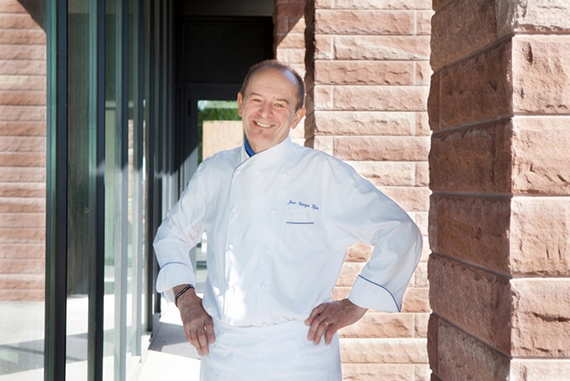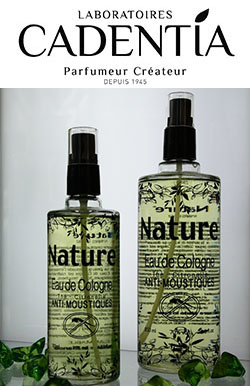Villa Rene Lalique and Chef Jean-Georges Klein awarded two stars by the 2016 Guide Michelin
Last February 1, little more than three months after opening, Villa René Lalique was awarded two Michelin stars.
The two stars bear testimony to the consistent quality of the culinary delights offered by Chef Jean-Georges Klein, who has been in charge of the establishment’s kitchens since its opening on 18 September 2015.
Responding to the news, Silvio Denz, Chairman and CEO of Lalique, said: “We are extremely proud to receive this recognition, which pays tribute to the savoir-faire and determination of our teams, both behind the stoves and front of house.”
“It is very touching to be honoured in this way by the Guide, just three months after starting operations. The achievement belongs to our entire team, notably Chief Executive Jérôme Schilling, Sous-Chef Michel Scheidler, Maître d’Hôtel Patrick Meyer, Chef Sommelier Romain Iltis
(Meilleur Sommelier de France 2012 and Meilleur Ouvrier de France 2015), Chef Pâtissier Nicolas Multon, Head Receptionist Julie Klein and Head of Housekeeping Murielle Laufer, as well as my wife Nicole Klein.” adds Chef Jean-Georges Klein.
Described as the most humble Chef in France, Jean-Georges Klein gained three Michelin stars in the kitchen of his celebrated restaurant the Arnsbourg-Hôtel K at Baerenthal. With characteristic passion and enthusiasm the Chef put his stars “back on the line”, leaving his family’s restaurant and launching himself into the great adventure of Villa René Lalique.
Chef Jean-Georges Klein has stayed faithful to what he knows best: conveying emotions. His dishes are bold but minimalist: “Every day, I try out unlikely combinations and contrasts. I experiment. I take risks ….” His cuisine is highly colourful, constantly evolving, resolutely refined and rich in contrasts of appearance and taste. It is a cuisine which uses juxtaposed tastes to surprise his diners’ palates.
A challenge he pulls off with brilliance, earning Villa René Lalique the rich reputation it deserves.
About Villa René Lalique:
The Villa built by René Lalique in 1920 at Wingen-sur-Moder, Alsace, has reinvented itself. On the initiative of Silvio Denz, Chairman and CEO of Lalique, the Villa is now the sumptuous setting for an ultra-sophisticated hotel and gourmet restaurant. A showcase for Lalique’s craftsmanship and flair, Villa René Lalique is a heartfelt tribute to French Art de Vivre.
The Villa built by René Lalique in 1920 has reinvented itself. Under the direction of Silvio Denz, Chairman and CEO of Lalique, the Villa has been transformed into the sumptuous setting of an ultra-sophisticated hotel and gourmet restaurant. A showcase for Lalique’s craftsmanship and flair, Villa René Lalique offers six exclusive suites. The décor was commissioned from interior designers Lady Tina Green and Pietro Mingarelli. Chef Jean- Georges Klein, decorated with three Michelin stars, presides in the restaurant built by Mario Botta, the Swiss architect of international renown. Deployed around Chef Klein is a brigade of fifteen people creating an array of gastronomic delights. Romain Iltis, the Villa’s Sommelier of distinction from Alsace was awarded ‘Meilleur Ouvrier de France’ in 2015 and ‘Meilleur Sommelier de France’ 2012. He is in charge of the exceptional cellar – one of Europe’s finest – with over 20,000 bottles in stock.
A heartfelt tribute to the French Art de Vivre, Villa René Lalique opens its doors to the public on September 18, 2015.
History
To appreciate the history of Villa René Lalique, it is necessary first to understand who René Lalique was, and what he brought to the iconic Maison he founded.
Lalique: the very name is the stuff of legend. Lalique: symbol of light and transparency, sparkling crystal, elegantly designed jewelry, artistic tableware and precious perfume bottles. The creator of all this was visionary artist, René-Jules Lalique, born in 1860 in Ay, a hamlet in the Marne region of France. From his early youth, he took an interest in art and design. He studied to become a goldsmith and designer at the École des Arts Décoratifs in Paris.
 This brilliant young prospect was immediately hired by celebrated jewellers of the day including Boucheron, Vever and Cartier. In 1878 he moved to London for two years, attending courses at Sydenham Art College. Back in Paris, he spent four years working as a freelance designer for several jewellers before starting his own jewellery business. From 1888, he engraved his first gold ornaments, inspired by classical antiquity and by Japonism. Already an innovator, he embellished his creations with surprising materials that broke the rules of his day. He would mix gold and precious stones with semi-precious stones, enamel, glass, leather, horn, even mother-of-pearl. His philosophy: “Better to seek beauty than flaunt luxury.”
This brilliant young prospect was immediately hired by celebrated jewellers of the day including Boucheron, Vever and Cartier. In 1878 he moved to London for two years, attending courses at Sydenham Art College. Back in Paris, he spent four years working as a freelance designer for several jewellers before starting his own jewellery business. From 1888, he engraved his first gold ornaments, inspired by classical antiquity and by Japonism. Already an innovator, he embellished his creations with surprising materials that broke the rules of his day. He would mix gold and precious stones with semi-precious stones, enamel, glass, leather, horn, even mother-of-pearl. His philosophy: “Better to seek beauty than flaunt luxury.”
 By 1890, René Lalique had gained recognition as a leading protagonist of the French Art Nouveau movement in jewellery design. He drew inspiration from the natural world and used the female body as pure ornamentation. A member of the avant-garde, he used the most elaborate techniques to produce original and imaginative creations. These pleased the academic and artistic elite, who challenged convention. His mission, in his own words, was “to create something never before seen”, and this led to him being dubbed ‘the inventor of modern jewellery’ by fellow Art Nouveau jewellry artist, Emile Gallé, in 1897.
By 1890, René Lalique had gained recognition as a leading protagonist of the French Art Nouveau movement in jewellery design. He drew inspiration from the natural world and used the female body as pure ornamentation. A member of the avant-garde, he used the most elaborate techniques to produce original and imaginative creations. These pleased the academic and artistic elite, who challenged convention. His mission, in his own words, was “to create something never before seen”, and this led to him being dubbed ‘the inventor of modern jewellery’ by fellow Art Nouveau jewellry artist, Emile Gallé, in 1897.
The Paris Exposition Universelle of 1900 marked the peak of Lalique’s career as a jeweller. This was the moment when he decided to move into the glassmaking industry. Perfume bottles, clocks, caskets, vases and sculptures were soon in production at his Clairefontaine property near Rambouillet. Jewellery and glassware went on sale from 1905 in a new shop on Paris’s Place Vendôme. In 1907 the perfumer François Coty, enchanted by René Lalique’s creations, invited him to lend his talent to the perfume business.
Already a master of Art Nouveau jewellery, in 1920 René Lalique became the master of Art Deco glassmaking. In 1921 he built the glassworks at his factory in Wingen-sur- Moder, Alsace, not far from the site where he commissioned the building of the Villa, one year before, to serve as his main residence during his stays in Alsace. As an inspired and eclecticartist,healsodesignedmascotsforluxurycars.He contributed to the interior decor of the legendary Orient Express train (1929) and the ocean liner Le Normandie (1935). 1935 was also the year when Lalique opened his shop at 11 Rue Royale in Paris.
Born in 1900, René’s son, Marc Lalique followed in his father’s footsteps, studying at the École des Arts Décoratifs in Paris and joining him in 1922. Following the death of René in 1945, Marc took the helm of the business and modernized the Wingen-sur-Moder factory. He moved out of glassware once and for all, to concentrate on crystal. The contrast between clear and frosted glass was to become world famous and Lalique’s technique made the brand synonymous with the distinction. Marc Lalique was the driving force behind Lalique as a manufacturer of crystal, soon to rank among the great crystal producers of France and beyond.
Continuing the work of her father and grandfather, Marc’s daughter, Marie-Claude Lalique also proved capable of adapting to the whims of fashion and reinventing herself through a blend of tradition and renewal. She served as Creative Director of Lalique until 1996, creating a range of bright, diverse crystal colours. Under her direction, Lalique returned to perfumery. The dedicated ‘Lalique Perfumes’ range, launched in 1992, owed much to her grandfather’s heritage. After going on safari in Africa, she devised creations of wildlife themes, including Bamara the lion and, in 1989, Zeila the panther.
Founded in 1888, today Lalique is one of the leading lights of French crystal production. Founder of the Maison and creative genius René Lalique was first known as the inventor of modern jewellery before becoming a master of glassmaking. With time, the Lalique name has become a powerful symbol of savoir-faire, synonymous with luxury, excellence, creativity, and an instantly recognizable style. Today, the Lalique brand is reinventing the creative and eclectic universe of René Lalique through contemporary creations in five fields: decorative objects, interior design, jewellery, fragrances and art. Lalique partners with other luxury goods brands, as well as leading artists and designers to create fresh, out-of-the- ordinary pieces that benefit from each partner’s expertise. For nearly a century, all Lalique crystal pieces have been made in France, at its factory in Alsace that was built in 1921.
Lalique is making its mark as a truly timeless brand of luxury and Art de Vivre.
THE HOTEL
SIX EXCLUSIVE SUITES
Steeped in history, the Villa was home to the founder and his family during their stays in Alsace. After René Lalique’s death in 1945, his son Marc and granddaughter Marie-Claude, continued to stay there on a regular basis. Silvio Denz, keen to breathe new life into the house, converted it into an exclusive hotel-restaurant. He commissioned interior designers Lady Tina Green and Pietro Mingarelli to carry out the refurbishment. They are the designers of the ‘Lalique Maison‘ Art-Deco inspired furniture and decorative accessories collection, created in 2011 and inspired by original René Lalique motifs. In accordance with Silvio Denz’s wishes, they have preserved the atmosphere and authenticity of the family home. With this requirement in mind, the exterior has been restored exactly as it once appeared, complete with blue shutters, faithfully reproducing the look of the original building. While retaining the original structure, the designers have imagined six suites that evoke the genius of René Lalique, down to the last detail. All different, they each bear the name of an emblematic René Lalique creation that harks back to a decade in the life of the master glassmaker. The exception is the ‘Zeila’ suite, named after Marie-Claude Lalique’s famous panther.
The black staircase, a replica of the original, leads to ‘Hirondelles’ on the first floor, a suite named after the beloved swallows of René Lalique.
 Red is the livery of this suite, which boasts nearly 44 m2 of floor space. The house bed linen, curtains, bed headboard and pillows match the colour of the bunches of grapes on the decorative panels which adorn the bedroom. Portraits of the master glassmaker on the wall remind us that we are actually in the room occupied at the time by René Lalique. The ‘Rose’ suite offers access for persons of reduced mobility with a generous 35.2 m2 of space. It is decorated in powdery pastel shades on a floral theme. Plant life was the artist’s preferred source of inspiration, especially when creating his Art Nouveau jewellery and Art Deco vases. Just along the passageway, lined with old photographs of Marie-Claude Lalique, is the ‘Zeila’ suite (25.1 m2), a tribute to the panther created by René Lalique’s granddaughter. The animal’s running silhouette shows off its powerful muscles, covered in fur which is a patchwork of myriad carved pieces of crystal. The last suite on the first floor is ‘Dahlia’, a spacious 39.50 m2 in beige and ivory shades. For the Dahlia motif, Lalique draws on its history by using glass, the founder’s original choice of material, and highlights the contrasts between frosting and transparency. On the second floor is the ‘Dragon’ suite (36.5 m2),
Red is the livery of this suite, which boasts nearly 44 m2 of floor space. The house bed linen, curtains, bed headboard and pillows match the colour of the bunches of grapes on the decorative panels which adorn the bedroom. Portraits of the master glassmaker on the wall remind us that we are actually in the room occupied at the time by René Lalique. The ‘Rose’ suite offers access for persons of reduced mobility with a generous 35.2 m2 of space. It is decorated in powdery pastel shades on a floral theme. Plant life was the artist’s preferred source of inspiration, especially when creating his Art Nouveau jewellery and Art Deco vases. Just along the passageway, lined with old photographs of Marie-Claude Lalique, is the ‘Zeila’ suite (25.1 m2), a tribute to the panther created by René Lalique’s granddaughter. The animal’s running silhouette shows off its powerful muscles, covered in fur which is a patchwork of myriad carved pieces of crystal. The last suite on the first floor is ‘Dahlia’, a spacious 39.50 m2 in beige and ivory shades. For the Dahlia motif, Lalique draws on its history by using glass, the founder’s original choice of material, and highlights the contrasts between frosting and transparency. On the second floor is the ‘Dragon’ suite (36.5 m2),
 that boasts a balcony large enough to sit and admire the magnificent view over the park. The suite also features a pleasant lounge space. The bed and other furnishings, in shades of midnight blue, reveal the beauty of this mythical creature. The dragon’s finely etched scales are set off by the purity of the crystal.
that boasts a balcony large enough to sit and admire the magnificent view over the park. The suite also features a pleasant lounge space. The bed and other furnishings, in shades of midnight blue, reveal the beauty of this mythical creature. The dragon’s finely etched scales are set off by the purity of the crystal.
 The result is a lively interplay of light and shade along its undulating body. Finally, the double suite ‘Masque de Femme’ (Mask of a Woman) is the largest in the Villa. Two bedrooms and a lounge together occupy 66.5 m2, extending over part of the second and the whole of the third floor. The suite is inspired by the panel created by René Lalique in 1935, which embodies all the imagination of its creator, who was fascinated by women, nature and mythology.
The result is a lively interplay of light and shade along its undulating body. Finally, the double suite ‘Masque de Femme’ (Mask of a Woman) is the largest in the Villa. Two bedrooms and a lounge together occupy 66.5 m2, extending over part of the second and the whole of the third floor. The suite is inspired by the panel created by René Lalique in 1935, which embodies all the imagination of its creator, who was fascinated by women, nature and mythology.
Furniture from the ‘Lalique Maison‘ collection was created specifically for the rooms of the Villa by the two interior designers. Lacquered beige, black, ebony or blue, this furniture exudes the purest in Art Deco style. For each suite and according to each theme, pieces of crystal decorate the bed frames, dressing tables, bedside tables, couches and mirrors. The bed linen and pillows are equally thought out according to the same six themes. Crystal is a ubiquitous presence in the luxurious bathrooms, each piece fitted perfectly for the bath and shower.
 These invite total relaxation, with their parkland views and marble in soft shades of beige. As the ultimate refinement, the tap handles are also made of crystal. Period photographs of the Villa, René Lalique and the whole family embellish the walls of the hotel, lending a personal and intimate touch to this place, steeped in history.
These invite total relaxation, with their parkland views and marble in soft shades of beige. As the ultimate refinement, the tap handles are also made of crystal. Period photographs of the Villa, René Lalique and the whole family embellish the walls of the hotel, lending a personal and intimate touch to this place, steeped in history.
THE LOUNGE
Warm and welcoming with its ample settees embellished with crystal motifs, Lalique’s signature ‘Femme Ailée’ armchairs by Lalique Maison, its crystal light fittings, occasional tables and period photographs, this is the ideal room for settling in and sampling a cocktail or reading a good book.
 An extraordinary display cabinet in the sumptuous bar contains the unique carafes that Lalique has developed in tandem with great producers such as The Macallan whisky, Hardy and De La Tour cognac and Patrón tequila. Weather permitting, the terrace is a haven of peace where you can bask in the morning sunshine and look over the park, have breakfast, served by the Head of Housekeeping, Murielle Laufer, or simply enjoy tea or coffee.
An extraordinary display cabinet in the sumptuous bar contains the unique carafes that Lalique has developed in tandem with great producers such as The Macallan whisky, Hardy and De La Tour cognac and Patrón tequila. Weather permitting, the terrace is a haven of peace where you can bask in the morning sunshine and look over the park, have breakfast, served by the Head of Housekeeping, Murielle Laufer, or simply enjoy tea or coffee.
Villa René Lalique is an homage to the exceptional work of the craftsmen working in the Lalique factory and to the century- old heritage bequeathed to them by the visionary artist, René Lalique. It is conceived as a showcase for lifestyle and savoir- faire, the Lalique way.
ZOOMING ON…
Lady Tina Green and Pietro Mingarelli
Lady Tina Green and Pietro Mingarelli are the designers and manufacturers of the collection of furniture, decorative accessories, and fabrics known as ‘Lalique Maison‘. They were commissioned to transform the original house of René Lalique into a luxury hotel, Villa René Lalique, developing the entire project including all the décor and furniture, also commissioned to design and furnish the interior of the magnificent restaurant adjoining the Villa. They have managed to sublimate the original motifs of René Lalique and Art Deco style. The designer duo have a reputation for their work on large yachts: in fact Lady Green and Pietro Mingarelli first met while working on the design of a 36-metre yacht, fourteen years ago. This marked the start of their successful cooperation as talented designers and architects of apartments, yachts and houses all over the world.
THE RESTAURANT
This flagship building by Mario Botta makes no apology for being modern. A rectangle of glass, borne on columns of red Vosges sandstone, it forms an extension, linked to the house by an all-glass walkway. Its four glazed sides and plant-covered roof merge perfectly with the six acres of glorious parkland planted with hydrangea, chestnut, birch, beech, oak, spruce and blue cedar trees.
 This superb view conveys an irresistible sense of calm reassurance. As the architect explains: “The history of architecture is a history of different periods. Villa René Lalique dates from the early 20th century and has the character of that period. The restaurant (…) will be a contemporary expression, sensitive to present day.”
This superb view conveys an irresistible sense of calm reassurance. As the architect explains: “The history of architecture is a history of different periods. Villa René Lalique dates from the early 20th century and has the character of that period. The restaurant (…) will be a contemporary expression, sensitive to present day.”
 Seating 40 people in 200 m2 of dining space, the restaurant is a showcase for the mastery and expertise of Lalique and a haven of peace, looking out across a vast expanse of countryside. The setting and décor of the Villa René Lalique restaurant invites guests to treat themselves to an exceptional dining experience. In the dining room, the pendant crystal cascade of three ornate Windfall chandeliers set the scene in dazzling splendour. But the kitchen is part of the scene, too. Dominating the restaurant is the majestic black bar, studded with crystal that includes a hatch opening into the kitchen. Placed on the tables by Patrick Meyer, Restaurant Manager and his team, are glasses and carafes from the 100 Points range, conceived for Lalique in 2012 by the celebrated American wine critic, James Suckling. Diners discover other embellishments created exclusively for Villa René Lalique by Lalique and its major partners. Lalique and Christofle have devised serviette rings encrusted with pieces of the ‘Masque de Femme’ in crystal. The crystal cruets, designed by René Lalique in 1924, have been revived. For these new models, Peugeot has built and adapted the original salt and pepper grinding mechanisms (these creations are available for sale).
Seating 40 people in 200 m2 of dining space, the restaurant is a showcase for the mastery and expertise of Lalique and a haven of peace, looking out across a vast expanse of countryside. The setting and décor of the Villa René Lalique restaurant invites guests to treat themselves to an exceptional dining experience. In the dining room, the pendant crystal cascade of three ornate Windfall chandeliers set the scene in dazzling splendour. But the kitchen is part of the scene, too. Dominating the restaurant is the majestic black bar, studded with crystal that includes a hatch opening into the kitchen. Placed on the tables by Patrick Meyer, Restaurant Manager and his team, are glasses and carafes from the 100 Points range, conceived for Lalique in 2012 by the celebrated American wine critic, James Suckling. Diners discover other embellishments created exclusively for Villa René Lalique by Lalique and its major partners. Lalique and Christofle have devised serviette rings encrusted with pieces of the ‘Masque de Femme’ in crystal. The crystal cruets, designed by René Lalique in 1924, have been revived. For these new models, Peugeot has built and adapted the original salt and pepper grinding mechanisms (these creations are available for sale).
 Busy at the kitchen range, surrounded by a brigade of fifteen, is Chef Jean-Georges Klein, previously from three-star Arnsbourg restaurant in Lorraine. With his Executive Chef Jérôme Schilling, his Sous-Chef Michel Scheidler, and the rest of the team, he has compiled several menus that demonstrate the taste of his creative cuisine. Dishes range from fillet of line-caught bass to marbled foie gras with Mirabelle plum and roast pigeon breast, rounded off with potato cappuccino and truffles. His is a colourful cuisine, full of contrasting looks, tastes and textures. It is a “Cuisine for four seasons,” he says. “My country is the world,” he claims. “I take a spice which comes from far away, an herb from the local forest, and I cook them with a fish from the Mediterranean or one of the oceans!” Working with him is Head Sommelier, Romain Iltis, with whom he drew up the menu to finalize the matches between dishes and wines. The dishes perfectly highlight all of the flavours and aromas of the recommended wines. Like René Lalique, pastry Chef Nicolas Multon draws his inspiration from flora with names that transport us to the heart of the northern Vosges: ‘Fruit of the Forest,’ ‘A touch of Vosges sandstone’.
Busy at the kitchen range, surrounded by a brigade of fifteen, is Chef Jean-Georges Klein, previously from three-star Arnsbourg restaurant in Lorraine. With his Executive Chef Jérôme Schilling, his Sous-Chef Michel Scheidler, and the rest of the team, he has compiled several menus that demonstrate the taste of his creative cuisine. Dishes range from fillet of line-caught bass to marbled foie gras with Mirabelle plum and roast pigeon breast, rounded off with potato cappuccino and truffles. His is a colourful cuisine, full of contrasting looks, tastes and textures. It is a “Cuisine for four seasons,” he says. “My country is the world,” he claims. “I take a spice which comes from far away, an herb from the local forest, and I cook them with a fish from the Mediterranean or one of the oceans!” Working with him is Head Sommelier, Romain Iltis, with whom he drew up the menu to finalize the matches between dishes and wines. The dishes perfectly highlight all of the flavours and aromas of the recommended wines. Like René Lalique, pastry Chef Nicolas Multon draws his inspiration from flora with names that transport us to the heart of the northern Vosges: ‘Fruit of the Forest,’ ‘A touch of Vosges sandstone’.
ZOOMING ON…
Jean-Georges Klein
Chef Jean-Georges Klein has joined the kitchens of Villa René Lalique with many of his loyal collaborators, including his wife, Nicole, who takes over the hotel management and Julie, their daughter, who heads up reception. After studying hotel management in Strasbourg from 1967 to 1969, Klein became head waiter at the familial gourmet restaurant belonging to his mother, Lilly. Self-taught, he served as a head waiter until age 40 before applying his passion and perfectionism to cookery. After taking over the family restaurant, he won his first Michelin star in 1988, his second in 1998 and – supreme accolade – his third in 2002. Two years later, Jean-Georges was nominated ‘Chef of the Year’ by the Champérard fine dining guide. The Schlemmer Atlas (German equivalent of the Michelin Guide) followed suit; then the Bottin Gourmand directory awarded him a fourth star. His dishes are bold but minimalist: “Every day, I try out unlikely combinations and contrasts. I take the risk…”. His cuisine is highly colourful, constantly evolving, resolutely refined and rich in contrasts of appearance and taste. It is a cuisine that juxtaposes tastes to surprise his diners’ palates.
ZOOMING ON…
Mario Botta
This Swiss architect of international renown, who lives in Mendrisio in the Canton of Ticino, was commissioned to design the restaurant and cellar. He has won more than 50 prizes and awards for his architecture that reflect his ethical concerns. It is important to Botta that a building should fit its surroundings perfectly, both visually and from the environmentally. Having this aim in mind, he designed the restaurant at Villa René Lalique with its pillars in Vosges sandstone, its big bay windows looking over the natural setting and its plant-covered roof. He has completed many works in Europe, Japan, and the United States. Among the most famous are the Museum of Modern Art in San Francisco, the Tinguely Museum in Basel and the Cymbalista Synagogue at Tel Aviv University. His eclectic spirit has also inspired him to design a vase in cooperation with Lalique.
THE CELLAR
A remarkable feature of this new building is the wine cellar, also the work of Mario Botta. This is an experience in and of itself. As you descend the cellar steps make sure to stop and take a good look at the fourteen Eternal crystal panels, a joint collaboration with British artist Damien Hirst. The work features the butterfly, a favourite metaphor of both René Lalique and Damien Hirst, two artists sensitive to the paradox of its magical beauty: fleeting, yet perennial. The butterfly appears in three forms: Hope,
Love and Beauty.
Romain Iltis, Head Sommelier of Villa René Lalique, has taken the cellar under his wing. One of Europe’s finest cellars, it holds more than 20,000 bottles, including exquisite wines such as a vintage Yquem dated 1865. The cases of wine are in display cabinets so that visitors can view this exceptional collection that includes numerous wines from Alsace. Established in this region for nearly a century, Maison Lalique was keen to give these Alsatian wines pride of place on the list. Romain Iltis collects them directly from the winegrowers. To pay tribute to them and make them better known, Maison Lalique has joined forces with James Suckling to publish a ‘Guide to Great Wines of Alsace – Lalique & James Suckling’. This is a listing of 650 of the region’s wines, rated by the American wine critic. The wine list also includes a wide variety of American and Bordeaux wines, notably some century-old Sauternes, most purchased directly from the estates. Originating from the Denz family cellar, they have been treasured for generations. Also worth discovering are the wines from the estates owned by Vignobles Silvio Denz
in the Bordeaux region, Spain and Italy – a testimony to their owner’s love of wine. Also featured are the estates of Silvio Denz’s friends, indicated on the menu by the phrase ‘Partner and Friend of Lalique.’ The result is a unique wine list with more than 20,000 bottles from all over the world. One thousand of these wines have received scores of 90-100 from the acclaimed wine critic, Robert Parker. More than one hundred of these wines have reached the highest score: 100 points.
The cellar is available for private hire for tastings and private or corporate events.
ZOOMING ON…
Romain Iltis
Previously awarded the title of ‘Meilleur Sommelier de France’ 2012, he has just won the accolade of ‘Meilleur Ouvrier de France’ 2015, in the sommelier category. Born in Alsace, he trained at the Alexandre Dumas Hotel College in Illkirch- Graffenstaden and began his career with Chef Alain Ducasse. He spent time at Le Chabichou Hotel in Courchevel before returning to his home region, joining the Verte Vallée Hotel in Munster as head wine waiter. In 2012, he teamed up with Chef Jean-Georges Klein at the Arnsbourg Restaurant in Baerenthal. Romain has a passion for wine, and is determined to share his enthusiasm. Given his background in cooking, he has a trained palate and knows how to make win-win matches between wines and dishes. The dishes complement the rich and complex aromas of the wines. At the same time, the wines set off the full flavours of the dishes they accompany.
PRACTICAL INFORMATION
ATTRACTIONS WITHIN REACH OF THE VILLA
The village of Wingen-sur-Moder lies at the heart of the Northern Vosges Regional Nature Park. Villa René Lalique is the perfect destination for lovers of nature, culture, gastronomy and wine.
CULTURAL ACTIVITIES
Musée Lalique – the museum built by architect Jean- Michel Wilmotte – opened to the public in 2011. It is a must-see attraction for Lalique enthusiasts, beautifully encapsulating the artist’s entire creative output. The costume jewellery exhibited illustrates the radical new wave of jewellery design created by René Lalique. An exceptional large-screen video transports visitors back to the Paris Exposition Universelle in 1900, a key date in the artist’s life. This marked a turning point in his career as a jeweller. There are also more than 230 perfume bottles to admire, on loan from Silvio Denz, a great collector. Inspired by René Lalique’s meeting with François Coty, these perfume bottles marked the former’s changeover from jewellery to glassmaking. Museum tours conclude with a film outlining the different stages in the manufacture of the legendary Bacchantes vase and a revealing look at the exceptional craftsmanship of the factory’s artisans.
Strasbourg – an easy hour’s drive away, or 35 minutes by train (from Wingen-sur-Moder station). Take the opportunity to (re)discover this city’s many and diverse charms: from the Cathedral in Petite France by way of the European institutions and the Palais Rohan.
Many castles and historic sites are worth stopping to see: the troglodyte cave dwellings at Graufthal and the castle and museum of Alsatian traditions at La Petite Pierre.
OPEN-AIR RECREATION
As the Villa lies in the northern Vosges range, nature lovers will enjoy exploring the region on foot, on horseback or by mountain bike.
OPENING DATES AND TIMES:
The hotel and restaurant are closed on Tuesdays and Wednesdays. The restaurant is closed at lunchtime on Saturdays.
LOCATION
8, rue Bellevue – 67290 – Wingen-sur-Moder – France Five minutes from Lalique Museum and Factory.
GETTING THERE
BY CAR
- Coming from Strasbourg: A4 towards Paris, exit 46 • Coming from Paris: A4 towards Strasbourg, exit 43
BY PLANE
- Strasbourg Entzheim: 59 km • Baden-Baden (DE): 70 km?• Basel-Mulhouse: 172 km?• Frankfurt (DE): 190 km
BY TRAIN
Wingen-sur-Moder from Strasbourg TGV station and Saarbrücken Hauptbahnhof (DE)
HELIPORT IN THE VILLA GROUNDS
Lalique is exclusively available at Rustan’s Makati, Shangri-la and Cebu.















